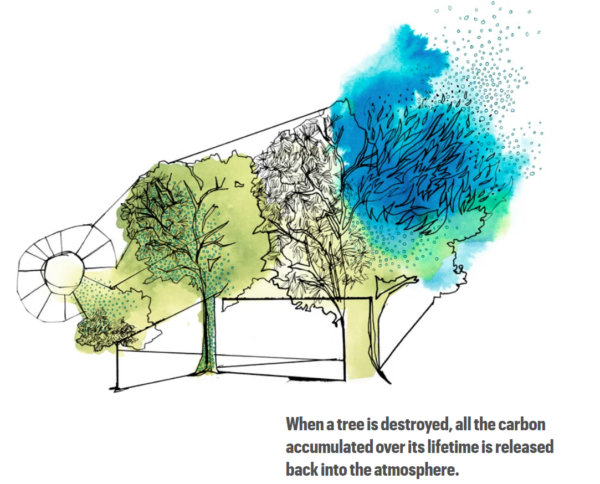Here are 23 Times Carbon Offsets Were Found to be Dodgy
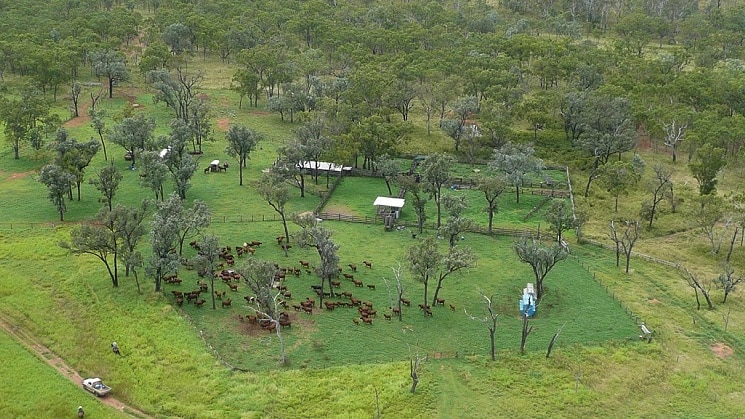
Carbon offsetting has received a lot of attention recently. As businesses and governments look to meet their climate targets, many are turning to carbon offsets. That is, they are paying someone else to reduce or avoid putting greenhouse gases into the atmosphere, so they don’t have to.
Yet, study after study, and report after report, exposes serious integrity issues with carbon offsets – both here in Australia and globally. Carbon offsets are issued and deployed at an array of scales, around the world – sometimes voluntarily, sometimes to meet obligations under regulations. Across these various forms of carbon offsets, the thing that seems to be common are questions over their quality.
Here we bring together a list of just some of the many studies and independent investigations that, collectively, highlight the general lack of integrity of carbon offsets. Across the various locations and methodologies surveyed here, all raise serious questions about continued reliance on carbon offsets to meet climate mitigation goals.
As these studies show, depending on carbon offsets to avoid dangerous climate change is fatally flawed. Offsets are deployed to justify continued emissions, just as we need to be directly scaling down our use of fossil fuels.
1/ Australia’s Safeguard Mechanism using credits from HIR projects with ‘negligible’ impact.
Australian human-induced native forest regeneration carbon offset projects have limited impact, research by Andrew Macintosh, Don Butler, Pablo Larraondo, Megan C. Evans, Dean Ansell, Marie Waschka, Rod Fensham, David Eldridge, David Lindenmayer, Philip Gibbons & Paul Summerfield, communications, earth & environment, 2024.
Key Finding: Research conducted by Macintosh et al found that the 182 assessed HIR projects do not increase vegetation cover or sequester carbon anywhere near the extent the Australian Carbon Accounting Model claims. The Australian Government has purchased an estimated $300 million in credits from HIR projects.
“There was only a small positive overall increase in forest cover (3.6%), and negligible increase in combined sparse woody and forest cover (0.8%), across the combined 3.4 Mha credited area…”

2/ The Guardian (and others) found that 90% of rainforest carbon offsets are worthless.
Revealed: more than 90% of rainforest carbon offsets by biggest certifier are worthless, analysis shows, Patrick Greenfield, The Guardian, 2023.
Key Finding: This research, conducted by The Guardian, Die Zeit and SourceMaterial, looked at forest carbon offsets approved by Verra – the world’s leading certifier of offsets for the voluntary market. It found that more than 90% of these certified rainforest offsets “did not represent genuine carbon reductions”.
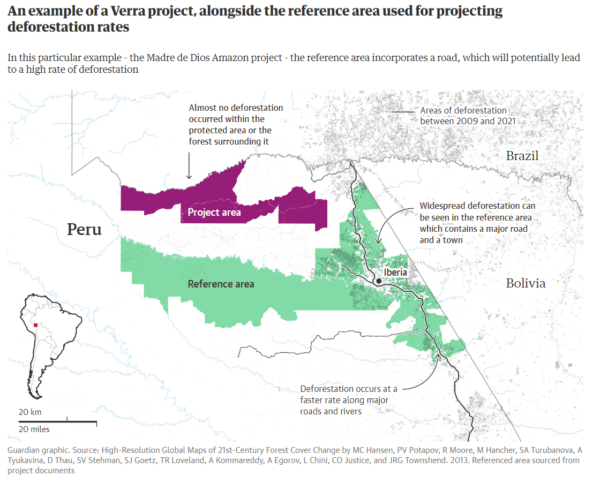
3/ Of 2,000 major offset projects, only 12% led to real emissions reductions.
Systematic review of the actual emissions reductions of carbon offset projects across all major sectors, Benedict Probst, Malte Toetzke, Laura Diaz Anadon, Andreas Kontoleon, Volker, Hoffman, pre-print article, 2023.
Key Finding: This research looked surveyed existing empirical studies of more than 2,000 offset projects. The research looked at several different offset types, finding that 0% of offsets for renewable offsets let to real emissions reductions, 0.4% for cookstoves, 25% for forestry, and 27.5% for chemical processes. Overall, “88% of the total credit volume across these four sectors in the voluntary carbon market does not constitute real emissions reductions.”

4/ More than $700 million worth of Australian Carbon Credit Units leading to “very little change”.
Summary Results of Analysis of the Integrity Risk and Performance of Human-induced Regeneration (HIR) Projects using CEA data, Andrew Macintosh, Don Butler, Megan C. Evans, Marie Waschka and Dean Ansell, ANU, 2023.
Key Finding: This research looked at Australian Carbon Credit Unit (ACCUs) issued under the ‘Human-Induced Regeneration’ method. Generally, these credits are awarded where a change in grazing practices by landholders allows for tree cover to regenerate, thereby drawing down carbon. This research surveyed 189 HIR projects across Australia, and found that “the vast majority of HIR projects that have been credited to date have resulted in very little (and often negative) tree cover change”. As such, 24,600,748 ACCUs have been issued – worth $763 million at today’s prices – which have led to minimal, if any, carbon sequestration.
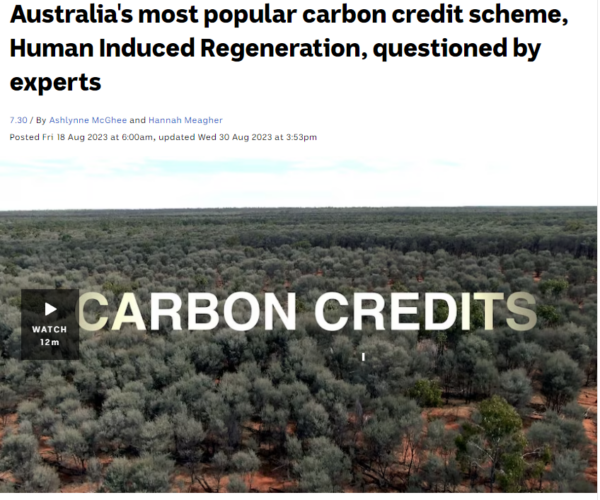
5/ Credits were granted for projects that would have happened anyway in UN-run Clean Development Mechanism
Do Carbon Offsets Offset Carbon? Raphael Calel, Jonathan Colmer, Antoine Dechezleprêtre, Matthieu Glachant, CESIFO Working Papers, 2021.
Key Finding: Under the UN-run Clean Development Mechanism, credits can be issued for renewable energy projects. This research surveyed 1,350 wind farms across India, considering whether they would have been viable without additional income from CDM credits. It found 52% of these projects would have been built anyway, meaning that “the sale of these offsets to regulated polluters has substantially increased global carbon dioxide emissions.”

6/ Inflated baselines lead to millions of junk carbon credits in a Zimbabwean avoided deforestation project.
The Great Cash-for-Carbon Hustle, Heidi Blake, The New Yorker, 2023.
Key Finding: Investigative reporting found that only fifteen million of the forty-two million carbon credits generated by a project in Zimbabwe represented legitimate avoided emissions. This investigation also raised questions about the share of benefits from carbon-credit income that went to local communities, compared to the company that ran the project.

7/ Junk ‘zombie’ offsets are being used being used to meet climate targets.
Data exclusive: The ‘junk’ carbon offsets revived by the Glasgow Pact Chloé Farand, Maribel Ángel-Moreno, Léopold Salzenstein and Jelena Malkowski, Climate Home News, 2022.
Key Finding: The world’s largest carbon offsetting program, the Clean Development Mechanism, has resulted in millions of carbon offsets with dubious climate benefits with some being associated with human rights abuses. Despite being over 10 years old these offsets are still being used to meet climate targets.
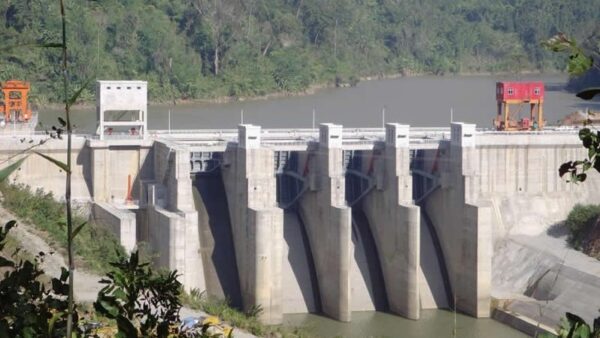
8/ The world’s biggest companies are making offsetting claims with old renewable energy projects.
Junk Carbon Offsets Are What Make These Big Companies ‘Carbon Neutral’ Akshat Rathi, Natasha White and Demetrios Pogkas, Bloomberg News, 2022.
Key Finding: One-third of the carbon offsets purchased from the 100 highest-selling projects in 2021 are tied to low-integrity renewable energy projects.
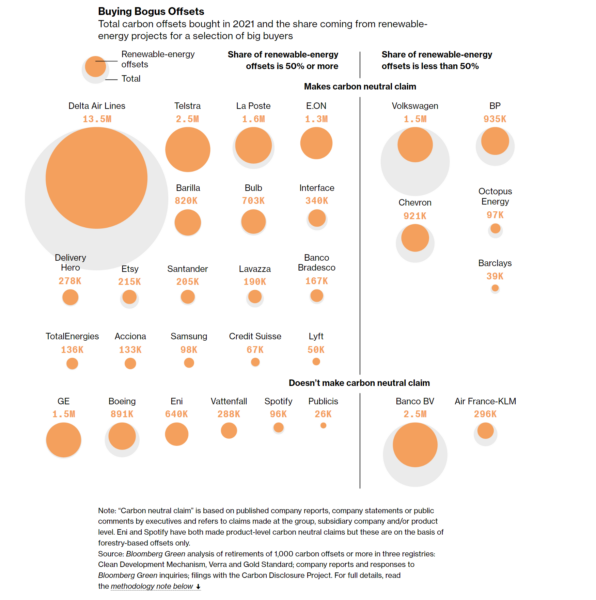
9/ Avoided deforestation projects do not avoid deforestation.
Action needed to make carbon offsets from forest conservation work for climate change mitigation Thales A.P. West, et al., Science, 2023.
Key Finding: This research looked at the effects of 26 avoided-deforestation projects, across 6 countries – all part of the UN’s REDD program, which seeks to reduce emissions and enhance the removal of greenhouse gases through forest management. Researchers found that most projects have not significantly reduced deforestation” and that “for projects that did, reductions were substantially lower than claimed”. This raises serious questions about the integrity of global carbon accounting.
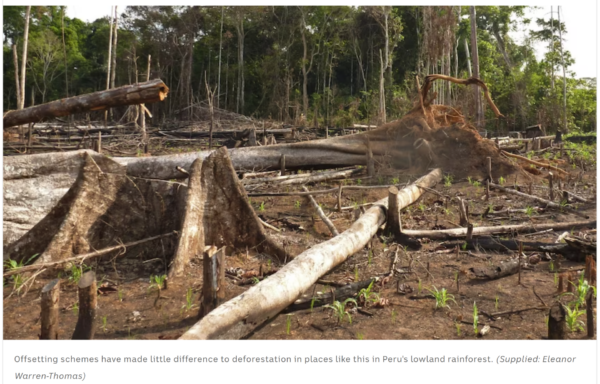
10/ Californian forest offsets may have actually increased emissions.
Little evidence of management change in California’s forest offset program, Jared Stapp, et al., Nature Communications: Earth & Environment, 2023.
Key Finding: This study looked at forest carbon offsets generated under the Californian state market. Analysis “failed to show additionality”, meaning that there no carbon emissions were reduced or offset by these projects. Following from this, “offsets increase net emissions if they do not reflect real emission reductions beyond the baseline scenario” – or, put simply, carbon offsets in California have resulted in increased emissions.

11/ Study finds that reduced deforestation credits “should not be treated as equivalent to fossil fuel emissions”
Quality Assessment of REDD+ Carbon Credit Project, Barbara K. Haya, et al., Berkeley Carbon Trading Project, 2023.
Key Finding: This major research project, developed by fourteen academics, assessed the effectiveness of REDD+ carbon crediting programs, all verified by Verra for the voluntary market. The research found that these REDD+ methods “generate credits that represent a small fraction of their claimed climate benefit. Estimates of emissions reductions were exaggerated across all quantification factors”. An implication of this is that “REDD+ credits should not be traded with, or treated as equivalent to, fossil fuel emissions.” In short, these carbon credits do not represent real emissions reductions.
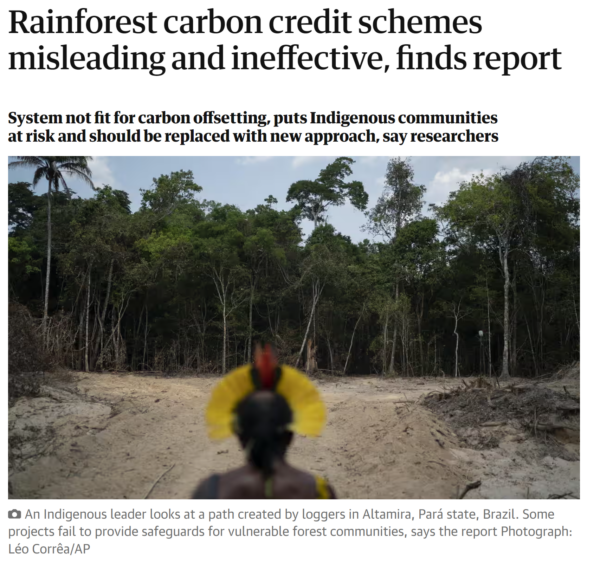
12/ Research shows that forestry carbon offsets based on flawed science.
Comprehensive review of carbon quantification by improved forest management offset protocols, Barbara K. Haya, et al., Frontiers in Forests and Global Change, 2023.
Key Finding: Improved Forest Management (IFM) offsets have produced 11% of global voluntary offsets to date “deviate from scientific understanding related to baselines, leakage, risk of reversal, and the accounting of carbon in forests and harvested wood products, risking significant over-estimation of carbon offset credits.” Put simply, these offsets are based on dodgy science, and where used to justify the use of fossil fuels elsewhere, result in increased emissions.

13/ Half of the Amazonian forests that were issued carbon offsets to prevent deforestation have been cleared.
Why Carbon Credits For Forest Preservation May Be Worse Than Nothing, Lisa Song, ProPublica, 2019
Key Finding: This report drew on satellite imagery of projects that were granted carbon credits for avoided deforestation in Brazil – that is, projects that protected forests from being cleared. Four years later, half of these areas had been cleared.
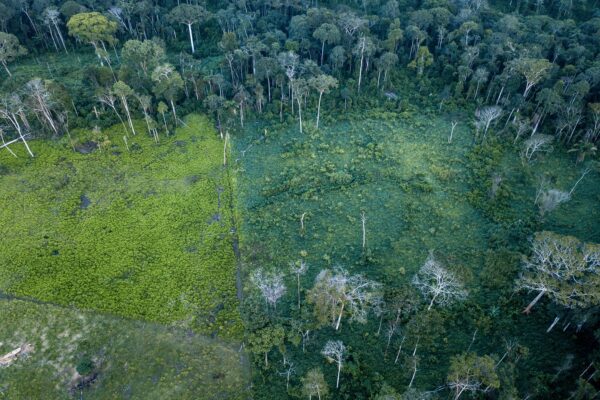
14/ Researchers found Australia is at risk of failing on climate targets, as the Safeguard Mechanism relies on broken offsets.
Why offsets are not a viable alternative to cutting emissions, Climate Analytics, 2023.
Key Finding: This research considered the integrity of ACCUs, as well as their use as offsets under the Safeguard Mechanism. Researchers calculated when ACCUs are used to mitigate emissions from LNG production, for every tonne of emissions saved 8.4 tonnes are released. For coal the equivalent figure is 58-67 tCO2e. The key finding here is that offsetting fossil fuel extraction leads to significant downstream emissions, even if the credits have integrity.
15/ Papua New Guinea REDD+ project generates 800 million carbon credits, despite no evidence of imminent forest clearing.
Carbon cowboys and cattle ranches: Submission on the proposed REDD+ project in Oro Province of Papua New Guinea, Polly Hemming and Andrea Babon, The Australia Institute, 2022.
Key Finding: Research analyzed a project proposal for a large, avoided deforestation project in PNG, which was credited by Verra. Research found that “The proponents have not adequately or credibly justified their assumptions around the current rate of forest loss… Nor have they demonstrated how the forest is at imminent risk of clearing that would only be curbed by the existence of the project.”

16/ Australian avoided-deforestation offsets assume an impossible increase in historic land clearing rates – of between 751 and 12,804 percent.
Questionable integrity: Non-additionality in the Emissions Reduction Fund’s Avoided Deforestation Method, Richie Merzian, Polly Hemming and Annica School, The Australia Institute and Australian Conservation Foundation, 2021.
Key Finding: This research looked at the avoided deforestation method in Australia. As of 2021, the Australian Government had bought 26.3 million ACCUs granted under this method, worth $310 million. The methodology used to create these credits was found to be fundamentally flawed, making heroic assumptions about future increases to land-clearing rates, of between 751 and 12,804 percent. Where these faulty credits are used to offset emissions elsewhere, total emissions continue to rise.
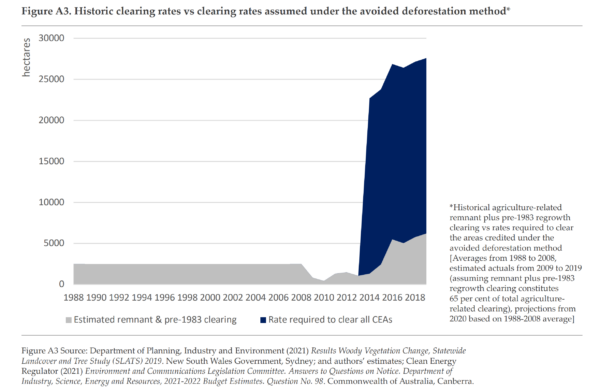
17/ 93% of the offsets used by fossil-fuel company Chevron to back up its ‘net-zero’ claims appear to be ‘junk’.
Destruction is at the heart of everything we do: Chevron’s junk climate action agenda and how it intensifies global harm, Rachel Rose Jackson and Adrien Tofighi-Niaki, Corporate Accountability, 2023.
Key Finding: Global fossil fuel giant Chevron has announced it will be ‘net zero’ by 2050. These claims rest on widespread use of carbon offsets and carbon capture and storage (CCUS) technologies. Both of these approaches are flawed: 93% of Chevron’s offsets have been found to have “low integrity”, and CCUS consistently fails to meet its targets – in some cases by 50%. Further, this study found that 42% of the carbon offsets used by Chevron are “linked to claims or allegations of inflicting harm on communities and spurring degradation of ecosystems, particularly in the Global South”. Finally, Chevron’s ‘net zero’ “aspiration” applies to only 10% of its emissions, leaving 90% unmitigated.

18/ Analysis finds that over $1 billion worth of carbon credits, from the global top 50 offset projects, are worthless.
Revealed: top carbon offset projects may not cut planet-heating emissions, Nina Lakhani, The Guardian and Corporate Accountability, 2023.
Key Finding: This analysis looked at the top 50 projects that have sold the most carbon offsets in the global market. The results found that 39 of these 50 projects, or 78% percent, were likely junk, and that eight others (16%) were problematic. The remaining 3 projects could not be assessed due to a lack of information. Projects were failed on various grounds, including: no additionality, exaggerated claims, inflated baselines, non-permanence, and leakage.
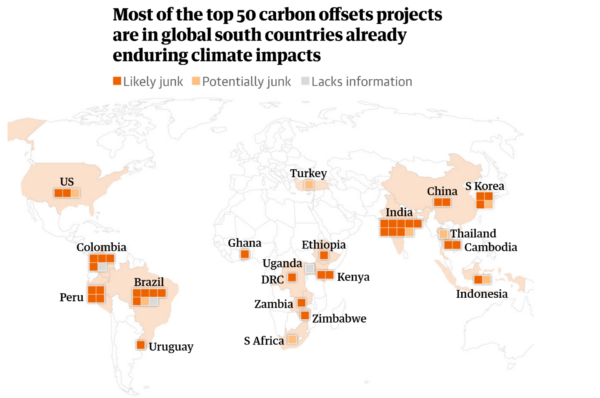
19/ Investigation found logging in forests that are supposed to be protected from deforestation.
Carbon colonialism, Stephen Long, Meghna Bali and Max Murch, ABC News, 2023.
Key Finding: This investigation looked at carbon offset projects, certified for the global voluntary market by Verra, in Papua New Guinea. Carbon credits from this project have been sold to the Sydney Opera House, Planet Ark, and Nespresso. But the forests that were supposed to be protected by these credits are being logged anyway. This ABC report also found that local communities were receiving less than a quarter of the returns from offset sales, with an Australian company taking the rest as profit.
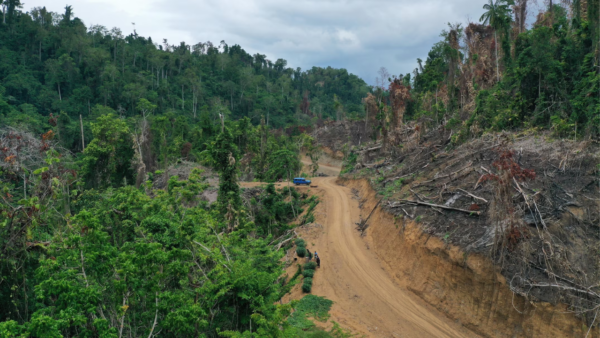
20/ Three-quarters of Kyoto Protocol Joint Implementation offsets are unlikely to represent real emission reduction.
Has Joint Implementation reduced GHG emissions? Lessons learned for the design of carbon market mechanisms, Anja Kollmuss, Lambert Schneider and Vladyslav Zhezherin, Stockholm Environment Institute, 2015.
Key Finding: This research considered the integrity of offset projects under the Kyoto Protocol, finding that three quarters of them were worthless. This analysis suggests that these offsets enabled around 600 million tonnes of additional greenhouse gas emissions– equivalent to a year of Australia’s total emissions.
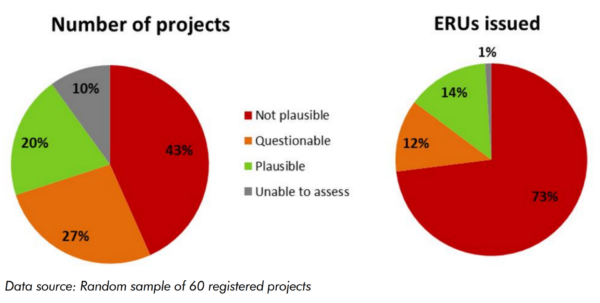
21/ The Norway government has found that emissions reductions from REDD+ projects are delayed and uncertain.
The Office of the Auditor General of Norway’s investigation of Norway’s International Climate and Forest Initiative, Office of the Auditor General, Norway, 2018.
Key Finding: The government of Norway has been a leading contributor to the REDD+ offset scheme since 2008. This research by the Auditor General found that emissions reductions from these projects were delayed by local political struggles, and that the gains from these projects are uncertain.
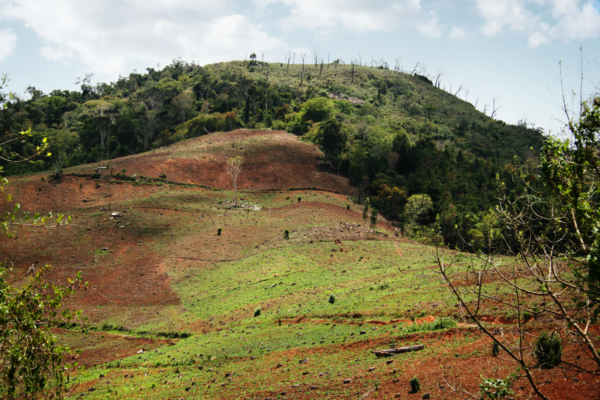
22/ Oxford University researchers found more 27% of ‘biodiversity units’ at ‘high risk of non-delivery’
Achieving biodiversity net gain by addressing governance gaps underpinning ecological compensation policies, Emily E. Rampling, Sophus O. S. E. zu Ermgassen, Isobel Hawkins, Joseph W. Bull, Conservation Biology, 2023
Key Finding: The English government is introducing a requirement that new infrastructure developments demonstrate they achieve a Biodiversity Net Gain (BNG). 27% of all Biodiversity Net Gain units fall within governance gaps that expose them to a high risk of non-compliance.

23/ Le Monde found carbon credits purchased by companies including Samsung, Air France, and Boeing, did not actually represent offset emissions.
Brazil: Three carbon offset projects accused of being scams, Anne-Dominique Correa, Le Monde, 2023.
Key Finding: Verra-certified carbon offset projects in Portel, Brazil, were found to not represent the emissions reductions claimed, and their legality has also been called into question, with accusations of using public land they declared to be private.

Australia needs a climate policy with integrity that drives genuine emissions reductions. Unless integrity is restored to Australia’s climate policies, Australia is fuelling a net zero fraud.
If you agree, add your name to our petition
Between the Lines Newsletter
The biggest stories and the best analysis from the team at the Australia Institute, delivered to your inbox every fortnight.
You might also like
The carbon con killing koalas
The NSW Labor Government took office promising to create a vast koala sanctuary on the state’s mid-north coast – the Great Koala National Park. Despite the threat of koala extinction in the state, more than a year later the Great Koala National Park is yet to be established.
Carbon Myth Industry | Mark Wootton
Australian agriculture doesn’t have enough capacity to offset its own emissions, according to Mark Wootton from Jigsaw Farms.
Why maintaining ambition for 1.5°C is critical | Bill Hare
One of the key things about this whole problem is that the only way to solve it is that we need to rapidly reduce and phase out fossil fuels. That can’t wait a decade. We need to be making substantial reductions this decade.
